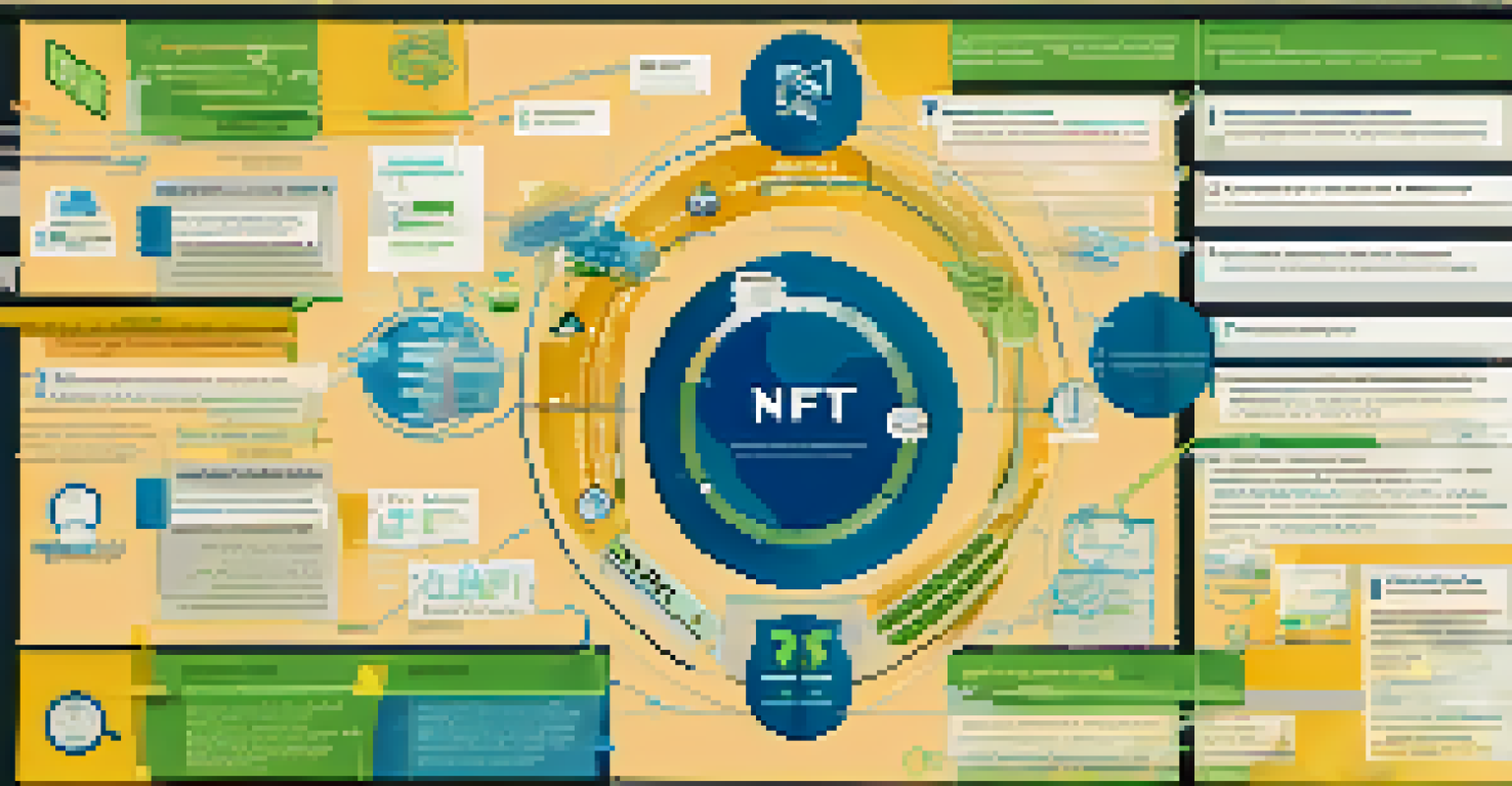Anti-Money Laundering Regulations and NFTs: What to Know

What Are Anti-Money Laundering Regulations?
Anti-Money Laundering (AML) regulations are laws designed to prevent the illegal practice of making 'dirty money' appear clean. These laws require financial institutions to monitor transactions and report suspicious activity, aiming to combat crime and terrorism financing. By enforcing these regulations, governments seek to maintain the integrity of financial systems and promote transparency.
Money laundering is a global issue that affects all economies. Understanding how to combat it is essential for the integrity of the financial system.
The core principles of AML regulations include customer identification, transaction monitoring, and record-keeping. Institutions are obligated to know their customers (KYC), which means verifying identities to ensure they are not engaging in illicit activities. This is crucial for preventing criminals from using legitimate channels to launder money.
As the digital landscape evolves, these regulations are increasingly applied to new asset classes, including Non-Fungible Tokens (NFTs). The growing popularity of NFTs raises questions on how these assets fit within the existing AML framework.
The Rise of NFTs and Their Appeal
NFTs, or Non-Fungible Tokens, have taken the digital world by storm, offering unique ownership of digital assets like art, music, and collectibles. Unlike cryptocurrencies, which are interchangeable, each NFT is unique, making them appealing to collectors and investors. This uniqueness gives NFTs significant value in the digital marketplace.

The allure of NFTs lies in their ability to provide provenance and authenticity, allowing artists and creators to monetize their work directly. With platforms like OpenSea and Rarible, the barriers to entry for artists have lowered, democratizing the art world in unprecedented ways. However, this rapid growth has also attracted attention from those looking to exploit the system for illicit purposes.
AML Regulations Combat Money Laundering
Anti-Money Laundering regulations are essential for preventing illegal activities by ensuring financial institutions monitor transactions and report suspicious behavior.
Consequently, the intersection of NFTs and AML regulations becomes crucial. As more money flows into the NFT space, there is an increased risk of money laundering, prompting regulators to take a closer look at how these digital assets are traded and sold.
How NFTs Can Be Used for Money Laundering
The unique nature of NFTs can make them appealing tools for money laundering. Criminals might purchase an NFT at an inflated price using illicit funds, then sell it to a legitimate buyer, thus 'cleaning' their money in the process. This cycle creates a façade of legitimacy around the transaction.
As digital assets like NFTs grow in popularity, so does the need for effective regulations to ensure they are not exploited for illicit purposes.
Moreover, the anonymity of blockchain transactions can further complicate regulatory efforts. While blockchain technology is designed to be transparent, the pseudonymous nature of wallets makes it challenging to trace the identity of individuals behind transactions. This poses risks for regulators trying to enforce AML compliance.
As the NFT market continues to grow, criminals may find innovative ways to exploit this space. Understanding how these transactions can be manipulated is key for regulators aiming to implement effective measures to curb illicit activities.
Current AML Regulations Impacting NFTs
As of now, many jurisdictions are still adapting their AML regulations to encompass digital assets, including NFTs. Some countries have begun to classify NFT platforms as Virtual Asset Service Providers (VASPs), placing them under the same regulatory scrutiny as traditional financial institutions. This classification requires these platforms to comply with KYC and transaction reporting regulations.
For example, in the European Union, the 5th Anti-Money Laundering Directive has expanded its scope to include virtual currencies, which indicates a trend towards stricter regulations for NFTs as well. Compliance with these regulations is not just a legal requirement; it also helps build trust with users and investors.
NFTs Pose Unique Regulatory Challenges
The rise of NFTs introduces complexities for regulators, as their unique characteristics and decentralized nature can facilitate money laundering if not properly monitored.
However, the implementation of these regulations can vary widely from one jurisdiction to another. This patchwork of regulations can create confusion for NFT platforms that operate globally, making it essential for them to stay informed about the legal landscape.
Key Challenges in Regulating NFTs
One of the main challenges in regulating NFTs is the rapid pace of innovation in the space. As new technologies and platforms emerge, regulators often struggle to keep up, leading to gaps in enforcement. This lag can allow bad actors to exploit these gaps for money laundering and other illicit activities.
Additionally, the decentralized nature of blockchain technology poses significant hurdles. Many NFT transactions occur on decentralized platforms that do not have a single point of control, making it difficult for regulators to enforce compliance. Without clear oversight, there is a risk that some platforms may prioritize profit over regulatory adherence.
Moreover, the diversity of NFT types—from digital art to virtual real estate—complicates the regulatory landscape even further. Each category may require different approaches and regulations, presenting a formidable challenge for policymakers.
The Role of NFT Platforms in Compliance
NFT platforms play a crucial role in ensuring compliance with AML regulations. By implementing robust KYC procedures, these platforms can help verify the identity of users and monitor transactions for suspicious activity. This proactive approach not only helps combat money laundering but also enhances the platform's credibility.
Many platforms are already adopting best practices by integrating advanced technologies like machine learning and artificial intelligence to detect unusual patterns. These tools can analyze transaction data and flag any inconsistencies that could indicate money laundering attempts.
NFT Platforms Must Ensure Compliance
NFT platforms play a vital role in combating money laundering by implementing robust KYC procedures and utilizing advanced technologies to monitor transactions.
By prioritizing compliance, NFT platforms can foster a safer environment for buyers and sellers. This commitment to transparency will ultimately help legitimize the NFT market and protect it from being tainted by illicit activities.
Future Outlook: AML Regulations and NFTs
As the NFT market continues to evolve, so too will the regulatory landscape. We are likely to see more countries implementing comprehensive AML regulations specific to digital assets, including NFTs. This shift could lead to a more standardized approach across jurisdictions, reducing confusion for platforms operating internationally.
Moreover, as public awareness of money laundering risks grows, consumers may start to prefer platforms with strong compliance measures in place. This demand could drive NFT platforms to invest more in their compliance infrastructure, ultimately benefiting the market as a whole.

In conclusion, while the intersection of AML regulations and NFTs presents challenges, it also offers opportunities for innovation and growth. By addressing these issues head-on, stakeholders can help ensure that the NFT market remains a legitimate and thriving space.